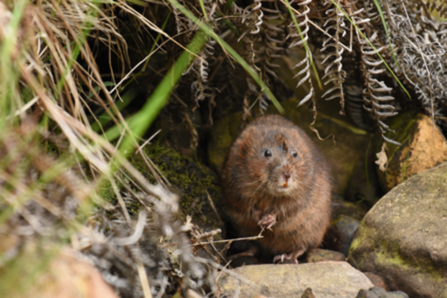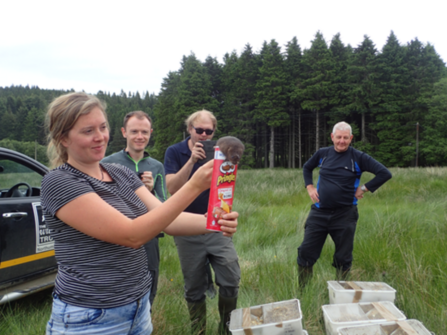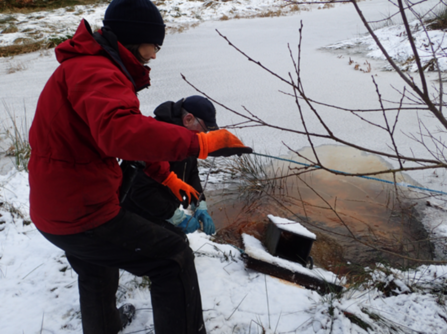As the four of us drove slowly out of Kielder Forest in the trusty old Isuzu the atmosphere was subdued. Memories and feelings were being shared as we reminisced about our adventures over what was almost a decade of work. The four were Sue Cornick, John Wollaston, Ellesse Janda and I. The last 4 standing. But many others had joined us at various times in the previous few years. Some just for the day, others for several years. But I was the sole survivor from the original cast of 16 volunteers who had attended our inaugural meeting in Bellingham in 2014. Then someone said “there’s book in there somewhere” and I thought “yes, there is, but will anyone write it”. So, being the only volunteer who had been there from start to finish of the project I did. With loads of help from fellow volunteers and staff at Northumberland Wildlife Trust.
RATTY RESTORED!

Water vole.
As a keen supporter of nature in the wild you will be aware of lots of work going on around this wildlife depleted nation to protect and enhance what’s left of our flora and fauna. You have probably come across several items in the media about rewilding and reintroductions. Now you can read about the largest reintroduction of the fabulous water vole in this new book., “Ratty Restored: A Vole, A Mink and A Man.”

Restoring Ratty van.
Restoring Ratty was a project long in the making. As alarming data about the decline of this special keystone species increasingly showed, something had to be done. Behind the scenes staff at NWT, the Tyne Rivers Trust and Forestry England put their heads together and came up with a plan. Tyne Rivers Trust initially took the lead in developing the plan with NWT to provide the wherewithal and Forestry England the ideal location. After much preparation a successful bid was made for funding and work could begin. The first task was to ensure that Kielder Forest would indeed be a suitable area.
As one of the main causes of the decline of the water vole was the presence of American mink we had to be sure that the forest was relatively free of this invasive predator which could wipe out a colony of water voles in very little time, as well as doing significant damage to other wildlife populations. The mink had been introduced to this country via the fur trade. Whilst they were already a growing pest matters became much worse in the 1990s as sales of mink coats plummeted and mink escaped or were released. Our first two years were spent monitoring for mink in the forest. This entailed putting out mink rafts throughout the area designated for the release of the voles and checking these on a regular basis. With dozens of rafts spread over an area of 250 square miles and accessed via forest tracks of varying quality this was a job for a team of volunteers. And we had some wonderful days doing this, encountering many interesting obstacles and phenomena on the way. In those early days Sue and I along with Don Learmouth, Dave Duffy, Steve Harris, John Bower and Robin Bailey were mainstays of the team.

Restoring Ratty water vole release.
Once we were reassured that mink are not a major threat in the forest funding was secured for the main, and most rewarding, part of the project. Finding some “volunteer” voles to take part, breeding a sufficient number and, best of all, releasing them into the wild. Initial funding from the Lottery Heritage Fund was for a 3 year period and the release of around 1,000 voles. Thanks to the early success and good publicity further funding from various sources extended the project so that eventually many more voles have been released. This was where the excitement really began. Visits to the Trossachs and Devon helped us prepare for what was to come. Now we were under the leadership of Kelly Hollings and Graham Holyoak, joint Ratty Tzars. First step in phase 2 was to recruit some water voles for a breeding programme. We were lucky to join Dr. Roisin Campbell-Palmer in collecting some suitable voles from the Allendale area. Others came from Scotland and North Yorkshire. Off they went to Devon to join Derek Gow’s breeding programme. And from the original crew of fewer than 40 breeding voles we have released over 2,000 of their descendants in Kielder Forest. Release weeks were always the highlight of each year. Getting up close to these beautiful mammals and watching them leave their release pens with either alacrity or reluctance. Some even performed for the press.

Restoring Ratty work in the snow.
When, after 5 years of releases, accompanied by continuing mink monitoring and annual population surveys the funding came to an end it was time to say farewell to the forest and its’ inhabitants. During our time we had been fortunate enough to see lots of wildlife and natural phenomena. Sue was lucky- or attentive - enough to once spot a Golden Eagle along the Scaup Burn whilst we often saw Osprey and Buzzards. Astral jelly and anal jelly (a clear jelly-like substance produced by otters) both caused a stir, as did the curious hair ice, and the mysterious purple pond. The good news is that the latest surveys showed that water voles were present at or near to all of the release sites and that there was evidence of them having spread out from there, particularly downstream of the dam. Unfortunately the national picture isn’t so rosy, although intensive work on the eradication of the American mink down in East Anglia seems to suggest that the vole population can recover if this threat is removed.
If you haven’t had enough of this story by now you can find much more about our adventures, and the welfare of our water voles in “Ratty Restored: A Vole, A Mink and A Man.” Available to buy from Hauxley Wildlife Discovery Centre and Northumberlandia visitor centres. You can also order through your local bookstore or get it online through our Northumberland Wildlife Trust shop.
Mel Rockett with his book 'Ratty Restored: A Vole, A Mink and A Man'.

